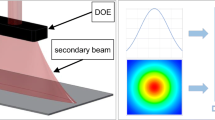Abstract
A deep penetration laser welding process differs from a heat conduction laser welding process in the generation of a steam capillary through the material. The so called keyhole is formed if high energy densities of the laser beam vaporize the base material, leading to a vapor-filled channel which is surrounded by a liquid weld pool. The shape and the oscillations of the keyhole are affected by various physical parameters of the welding process. Under constant process conditions a balance of pressure keeps the capillary open. If the material is contaminated by a layer with physical properties differing from the bulk material (e.g. oil), the equilibrium is disturbed in a negative way. The coating evaporates during the melting of the base material, resulting in vapor locks at the capillary and the weld pool, leading to pores and failures along the weld seam. In order to understand and avoid this effect, it is the aim to analyze and describe the failure generating mechanisms. Additionally, a control method of the laser power is investigated which influences the keyhole’s oscillations and could suppress an unwanted collapse.











Similar content being viewed by others
References
Steiger E (2007) What is the best choice for laser material processing—rod, disk, slab or fiber? In: Proceedings of the 26th international congress on applications of lasers and electro-optics, Orlando
Ebert C (2007) Laserapplication in the new Audi TT. In: Proceedings of the 8th European conference and exhibition, European automotive laser application, Bad Nauheim, pp 202–215
Ribolla A, Damoulis GL, Batalha GF (2005) The use of Nd:YAG laser weld for large scale volume assembly of automotive body in white. J Mater Process Technol 164–165:1120–1127
Kägeler C et al (2007) Investigating a laser welding process with methods of non-linear dynamics. In: Proceedings of the 4th international WLT-conference on lasers in manufacturing, Munich
Katayama S, Kawahito Y, Mizutani M (2007) Plume behaviour and melt flows during laser and hybrid welding. In: Proceedings of the 4th international WLT-conference on lasers in manufacturing, Munich
Fabbro R et al (2006) Experimental study of the dynamical coupling between the induced vapour plume and the melt pool for Nd–Yag CW laser welding. J Phys D Appl Phys 39:394–400
Klein T (1997) Freie und erzwungene Dynamik der Dampfkapillare beim Laserstrahlschweißen von Metallen, Dissertation. TU Braunschweig, Shaker Verlag
Chan CL, Mazumder J, Chen MM (1988) Effect of surface tension gradient driven convection in a laser melt pool: three-dimensional perturbation model. J Appl Phys 64(11):6166–6174
Honda H, et al. (2004) Monitoring of keyhole behaviour in deep penetration laser welding. In: Proceedings of the 23rd international congress on applications of lasers and electro-optics, San Francisco
Mizutani M, Katayama S (2003) Keyhole behavior and pressure distribution during laser irradiation on molten metal. In: Proceedings of the 22nd international congress on applications of lasers and electro-optics, Jacksonville
Acknowledgments
The work presented is carried out within the collaborative research area SFB396 founded by the DFG, Deutsche Forschungsgesellschaft.
Author information
Authors and Affiliations
Corresponding author
Rights and permissions
About this article
Cite this article
Geiger, M., Kägeler, C. & Schmidt, M. High-power laser welding of contaminated steel sheets. Prod. Eng. Res. Devel. 2, 235–240 (2008). https://doi.org/10.1007/s11740-008-0109-1
Received:
Accepted:
Published:
Issue Date:
DOI: https://doi.org/10.1007/s11740-008-0109-1




